Making Strategic Decisions when Creating Content
Understand what your customers are thinking, feeling, and doing at every step of the journey, before creating content.
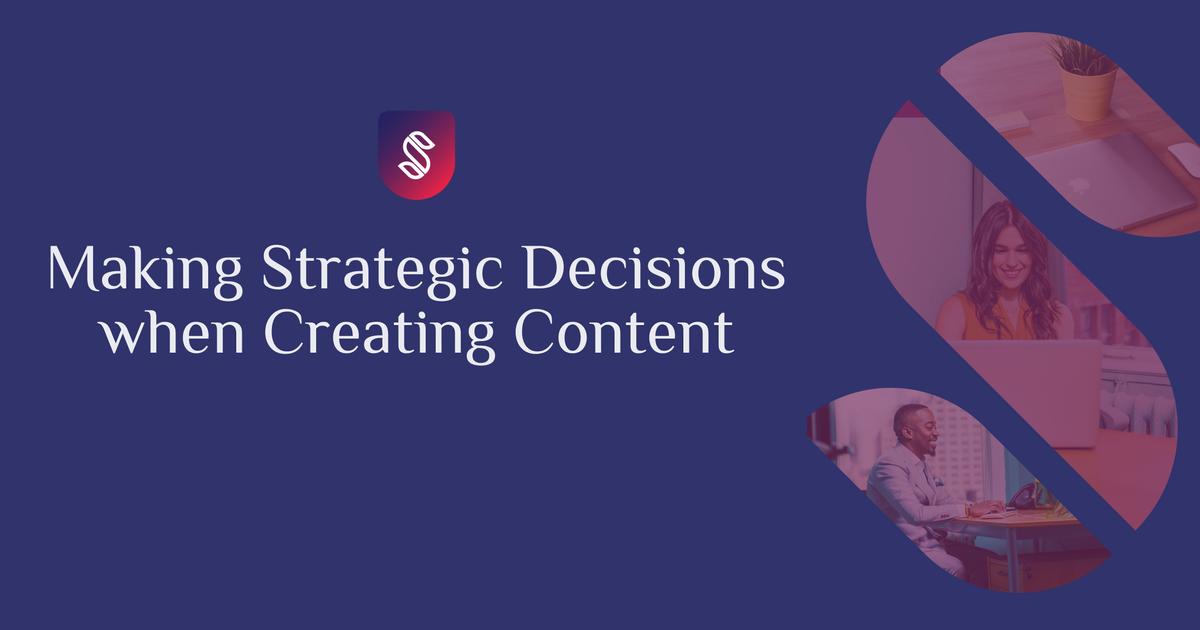
Content works if you understand what it’s supposed to do, and doesn’t if you treat it similarly to your other performance channels.
With paid ads, the equation is simple: you pay for results and you get them. With content marketing, things are a bit more complex, because you’re not pushing stuff to your users.
Instead, you’re trying to pull them in by presenting the service, solution, or product that you’re offering in the most appealing manner.
This works when the user is searching for exactly the thing that you’re offering. In other words, content marketing works when your offer — promoted through content — meets the user needs, and addresses their intent. But there is one more key element here: the timing.
To get the right message in front of the user at the right moment, you need to understand how a user thinks, feels, and behaves in each step of their journey on your website.
Then, you need to map your content to exactly those stages and touchpoints in a way that not only satisfies their needs but also helps you achieve your business goals.
The purpose of this article is to give you a better understanding of how to think when planning the types of content to create, by looking at what your customer is experiencing and mapping that to your business goals.
We’ll first look at the different types of journeys, the maps that you can create for understanding the users better, and in the second part, I’ll give a practical example of mapping content to the user journey.
Journeys, funnels, and maps — what should you choose?
These options vary greatly and there’s no wrong choice, so if you think an experience map is too complex for your current business and resources, feel free to choose a simpler model.
Regardless of what you choose, the process of mapping the content will go through the same steps.
NOTE: If you’re already familiar with these models, you can skip the reading and get the templates here: Journeys, funnels, maps.
Customer/user journey map
A customer journey map, as its name implies, focuses on the journey of a customer, or on the process that the user goes through when trying to accomplish a goal. This goal can be learning a new skill, buying a product or service, finding a location, and so on.
The design process starts with understanding the customer pain points and needs, so the focus is first on the why, and then on the what and how.
Since the journey is different depending on the goal of the customer, you should create one journey for each persona — goal combination.
In other words, if you’re selling 2 services, such as content marketing services and SEO consultancy, for example, you should map separate user journeys for each of these offerings.
Keep in mind that the journey should reflect the perspective of the user, not yours. So ideally you would back it up with analytics data or user insights from interviews.
Other important characteristics of the customer journey are that it looks at the process in chronological order, and it maps the phases and actions of the user with thoughts and emotions. So typically in a customer journey map, you have at least 4 levels/swim lanes.
Here’s a generic template:
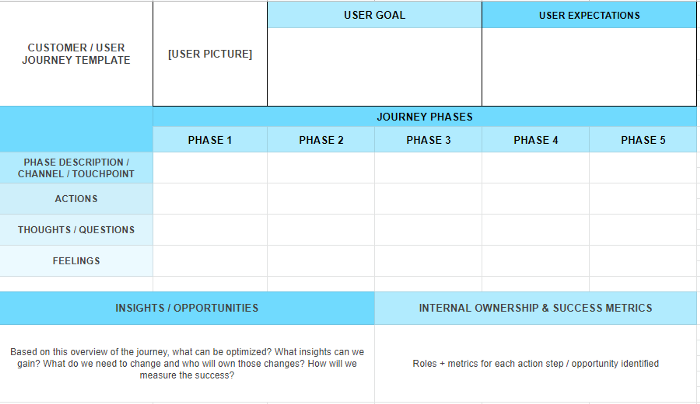
Image: customer journey map template
The customer journey map can be used before creating the content strategy or the design for a website, or when you don’t understand why users aren’t converting or taking specific actions.
Here are some examples of customer/user journey maps:
Experience map
An experience map is broader than a customer journey map, and it analyzes (maps) the entire experience a person goes through in order to accomplish a goal.
For example, the experience of traveling abroad, the experience of being pregnant, the experience of buying a new house.
All these are much more complex than the journey of a user on a website, and they look at both the experience of the person and the opportunities for the business. The intersection between these two is illustrated in the middle of the diagram.
An experience map is generally used before a customer journey map, to gain a deeper understanding of the human behavior that ultimately leads the person to your service or product.
This map looks at the end-to-end process, but without considering a specific offering. Here’s a sample template:
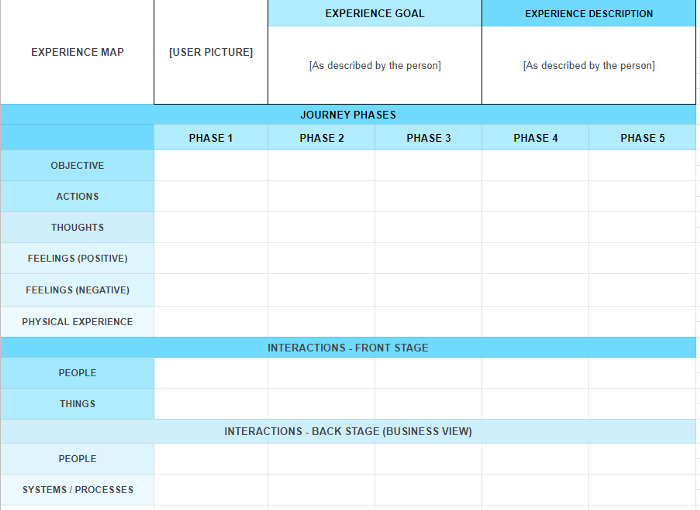
Image: experience map template
As you can see, the experience map looks at more than the actions, thoughts, and feelings of the person. But it starts by interviewing the person to learn about their experience, in order to understand the big picture.
Typically, you would ask the person to talk you through the steps involved in that specific experience. You can see some examples of experience maps here:
Empathy map
The role of this map is to help you understand how your user feels and thinks and what he does and says while interacting with your website. The model is simple:
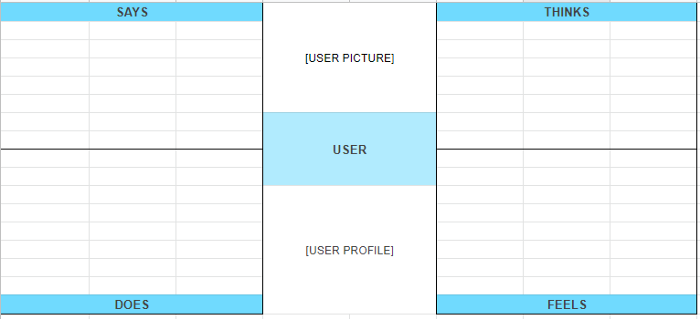
Image: empathy map
The 4 quadrants are quite self-explanatory, and they’re supposed to help you and your team understand the user’s perspective. Since this map is meant to build empathy towards a specific user profile, the exercise should be repeated for each persona.
Ideally, you should create these empathy maps at the beginning of a design/content planning/content strategy process.
However, you can also use this model after performing customer interviews, to help you organize the input and find patterns and differences.
You can see some examples of empathy maps here:
Day in the life map
This type of map looks at what your customer does on a regular day, and how they may use your product. It maps out the schedule, activities, places where they go, people that they interact with, as well as concerns and past times.
Here’s a generic template:

Image: dayiinlife
A day-in-the-life map can feel more personal than an empathy or customer journey map, as it forces you to walk in your customer’s shoes.
The exercise is extremely useful for understanding that your customers are regular human beings with regular thoughts, concerns, and problems, who might care more about getting home and paying the bills than about your latest innovation.
You can see an example here:
Service blueprint
A service blueprint describes a service offering, and unlike the previous maps, it focuses not only on the front stage (the customer experience) but also on the backstage.
Although it starts from what the customer experiences in his journey, it shifts the attention to the organization — the people, processes, and systems that support that journey.
A service blueprint is useful when you’re seeing that the user journey doesn’t go as smoothly as possible because the user is experiencing blockers and pain points in specific stages.
It’s also a good tool to use when you want to improve some internal processes but you’re not sure where to start from, as this type of mapping allows you to break down the processes and correlate your internal pain points with what the user experiences.
Here’s a generic template:
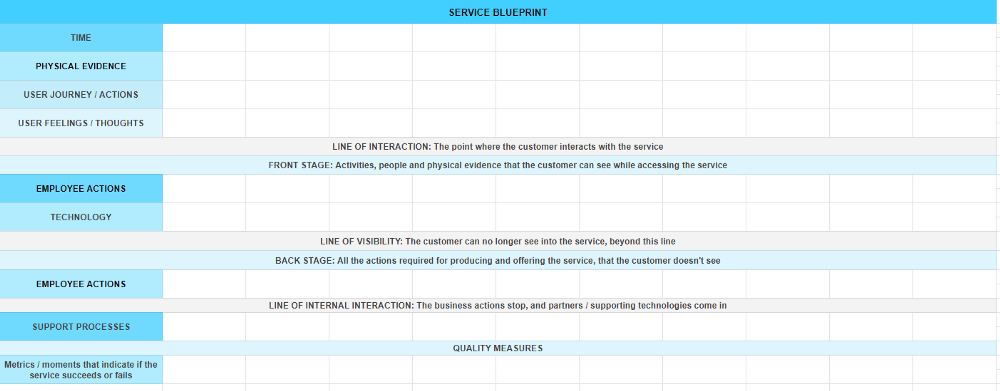
Image: service blueprint
Just like a user journey, the service blueprint is specific to a service and has four main swim lanes: actions of customers, front stage, backstage, and support processes. This map, too, is chronological and helps in identifying internal optimization opportunities.
You can see some examples of service blueprinting here:
If you need help in developing a service blueprint, customer journey or experience map for your business, get in touch with our team.
Current state / Future state maps
A current state map looks at the existing experience that a user has when accessing a service, and at the business side — people, processes, systems — involved in delivering the service.
It is similar to a content audit, as the purpose is to get an overview of what’s currently happening with a service, end-to-end.
Mapping the current state can help you identify improvement opportunities and gain a shared understanding of the service and the user experience across teams.
The future state map looks at a new service or product that you want to create and aims to clarify what the offering should be and what problem it should solve, what the ideal customer experience should look like, and the internal changes that might be needed for delivering that experience.
This type of map is useful when exploring a new offering, when defining the scope — to make sure it matches your resources, or when defining an MVP.
You can see some detailed examples here:
(Inbound) Marketing funnel
A marketing funnel is a system designed to attract users who might be interested in your offering and convince them to become clients (thus, to convert).
The inbound model is based on the idea that when you create the right solution and you promote it in the right channels, you will attract the right type of user that will become your customer.
So instead of “pushing”, you’re “pulling”. This is the opposite of outbound or traditional marketing, where the offering is thrown in the user’s face.
The inbound marketing funnel looks like this:

Image: mkt funnel
You can see examples and learn more here:
Sales funnel
Although the marketing and sales funnels are often seen as the same thing, the sales funnel actually looks at the user and the offering from a different perspective.
While the marketing funnel looks at the stages through which a user goes once attracted to a website, for example, the sales funnel will look at the actions needed for turning a “suspect” — non-interested person — into a customer.
For example, a sales guy may create a list of prospects and call them one by one to see if they’re interested in a solution. So the sales representative tries to “push” the offering and he might be the one approaching the potential customer first.
On the other hand, in the (inbound) marketing funnel, there isn’t any hard-selling and cold-calling involved. So is there any point where these two funnels interact, you may ask?
If an organization uses both funnels, they probably work with marketing qualified and sales qualified leads.
In this scenario, a potential customer is not approached by sales until he or she is “marketing qualified”, meaning that the user showed interest and became a lead while going through the marketing funnel.
Content funnel
In a content funnel, the focus is on what types of content to create for each stage of a marketing funnel, user journey, or whatever model you choose. The content funnel will go in parallel, not replace, your chosen map.
Typically, the content funnel looks at four stages:
TOFU (top of the funnel) — mainly the acquisition and activation of users;
MOFU (middle of the funnel) — lead generation and nurturing;
BOFU (bottom of the funnel) — conversion and retention;
Retaining the customers — up-sell and cross-sell, loyalty;
The TOFU content will mostly aim to raise brand awareness and to generate traffic. The MOFU content will focus on educating and informing the users so that they have a reason to convert or to come back.
The BOFU content needs to show the value of the product or service clearly enough to convert the users into customers. This content is focused on the product or service and personalized.
The Growth content looks into possibilities of doing repeat business with the acquired customers, and into turning them into brand advocates and referrals.

Image: content funnel
You can see some examples of content funnels and read more here:
In part II, we’ll look at a practical example of mapping content to the user journey. You can read the article here: Mapping Content to the User Journey
If you need help in deciding what map or funnel to use, get in touch with our team. We'll audit your content, define your ideal customer and goals, and recommend a plan of action.